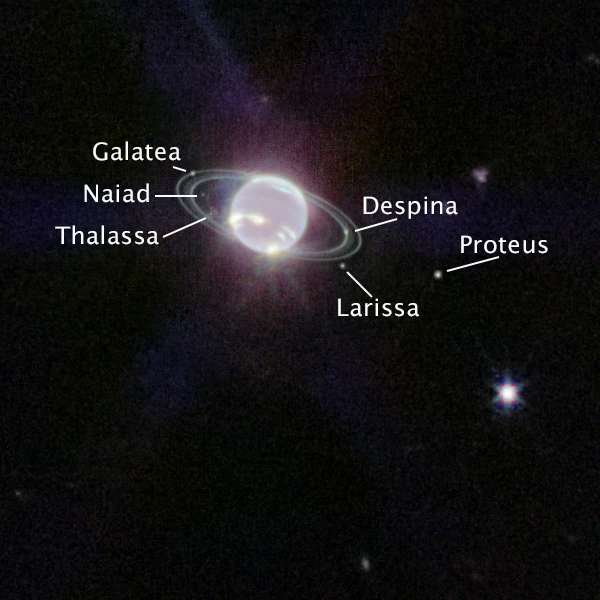
Neptune, the eighth planet of the Solar System, is surrounded by a complex system of 14 confirmed moons. These icy bodies, the most famous of which is Triton, form a dynamic and enigmatic ensemble. Triton, discovered in 1846, dominates this procession with its unique characteristics: retrograde orbit, geological activity, and nitrogen-rich composition. The other moons, such as Nereid, Proteus, or Larissa, have irregular orbits suggesting capture by Neptune's gravity.
The Neptunian system is dominated by Triton, which represents 99.7% of the total orbital mass. With a diameter of 2,700 km, it is the only major moon in the system. Its particularities include:
The other moons, such as Nereid (discovered in 1949), have eccentric and inclined orbits, while Proteus (1989) is the second largest satellite after Triton, with a dark and cratered surface.
The moons of Neptune are divided into two groups:
The capture of Triton would have disrupted the original system, explaining the absence of large prograde moons. Simulations suggest that Triton originated from the Kuiper Belt, and its arrival would have ejected Neptune's primordial moons.
| Moon | Diameter (km) | Mass (×1019 kg) | Orbit (days) | Particularities |
|---|---|---|---|---|
| Triton | 2 706 | 214 | 5.88 (retrograde) | Only major moon, geologically active |
| Proteus | 420 | 0.5 | 1.12 | Largest irregular satellite after Triton |
| Nereid | 340 | 0.3 | 360.1 | Most eccentric orbit (e = 0.75) |
| Larissa | 194 | 0.05 | 0.55 | Asymmetric shape, rich in water ice |
| Galatea | 176 | 0.04 | 0.43 | Influence on the Adams ring |
| Despina | 150 | 0.02 | 0.33 | Orbit inside the Le Verrier ring |
| Thalassa | 82 | 0.001 | 0.31 | Nearly circular orbit at 50,000 km |
| Naiad | 66 | 0.0002 | 0.29 | Closest known moon (48,227 km) |
| Halimede | 62 | 0.0001 | 1 879 | Possible fragment of Nereid |
| Psamathe | 40 | 0.00004 | 9 074 | Discovered in 2003, very distant orbit |
Sources: NASA JPL, Icarus (2023), Nature Astronomy (2022).
No dedicated mission to Neptune is currently underway, but proposals such as Trident (NASA) or Odysseus (ESA) aim to study Triton and its interaction with Neptune's magnetosphere. The technical challenges are significant due to the distance (4.5 billion km from the Sun), but the scientific stakes justify these efforts:
The moons of Neptune, particularly Triton, offer a unique window into the processes of capture and dynamic evolution in the outer Solar System. Their study could shed light on the formation of giant planets and the mechanisms of planetary migration. With future space missions, these icy worlds could reveal major surprises, reinforcing their status as natural laboratories for exoplanetology.